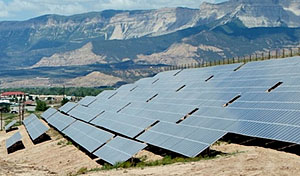
|
| Clean Energy Collective's solar arrays in Colorado. (Image Credit: Clean Energy Collective.) |
However, things are changing, and in the last several years or so, “shared solar” has started to take root in many states across the country. What exactly is shared solar and how does it differ from conventional solar?
Virtual Net Metering
One of the absolute necessities in the residential solar industry is net metering. On those days where the amount of electricity generated exceeds what is consumed, the power meter spins backwards, and surplus electricity is “sold” to the utility power company in order to lower energy bills. Net metering is a way for the state/government to incentivize solar power, making it more affordable for consumers.
Virtual net metering is almost identical to standard net metering, but instead of each homeowner having their own net metering “tab,” small or large communities can have them together, and each home gets bill credits representing their “share.” At the time of this writing, only a handful of states have virtual net metering in place (see www.dsireusa.org/solar/solarpolicyguide/?id=17), but several others are in the process of implementing it.
Community Shared Solar
The benefit of community shared solar is that instead of each individual homeowner having to put solar panels on their own roof, a flat piece of land in the community or an empty commercial roof could host them.
Virtual net metering is not an absolute requirement in order for shared solar to flourish. A separate company can own, operate, and maintain the solar community, and homeowners could become “subscribers.” This potentially could also lower or even eliminate the large upfront costs of solar — very similar to solar leasing/power purchase agreements (PPA).
If more of the “three in four residential buildings with restrictions to going solar” have the opportunity to become subscribers to local community shared solar power systems, the market for residential solar in the U.S. could see substantial gains.
Publication date: 10/8/2012


Report Abusive Comment